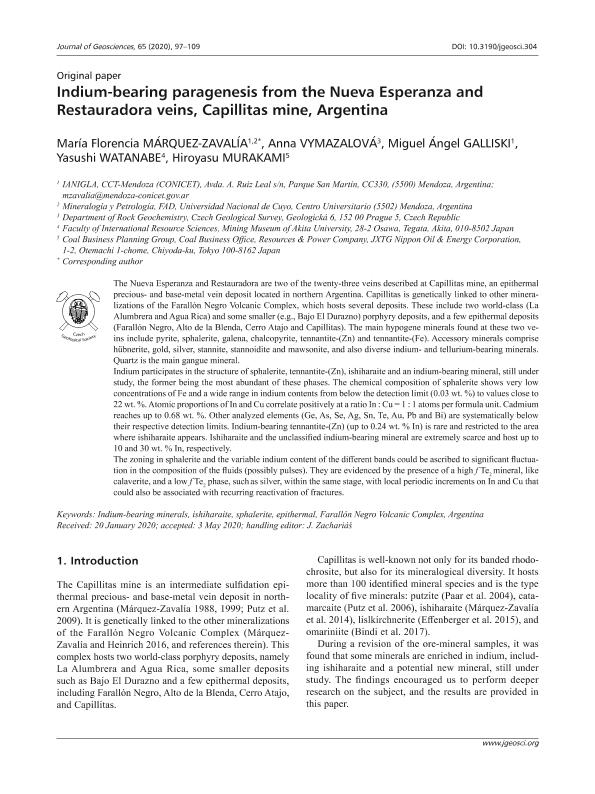Artículo
Indium-bearing paragenesis from the Nueva Esperanza and Restauradora veins, Capillitas mine, Argentina
Marquez Zavalia, Maria Florencia ; Vymazalová, Anna; Galliski, Miguel Angel
; Vymazalová, Anna; Galliski, Miguel Angel ; Watanabe, Yasushi; Murakami, Hiroyasu
; Watanabe, Yasushi; Murakami, Hiroyasu
 ; Vymazalová, Anna; Galliski, Miguel Angel
; Vymazalová, Anna; Galliski, Miguel Angel ; Watanabe, Yasushi; Murakami, Hiroyasu
; Watanabe, Yasushi; Murakami, Hiroyasu
Fecha de publicación:
08/07/2020
Editorial:
Czech Geological Survey
Revista:
Journal of Geosciences
ISSN:
1802-6222
e-ISSN:
1803-1943
Idioma:
Inglés
Tipo de recurso:
Artículo publicado
Clasificación temática:
Resumen
The Nueva Esperanza and Restauradora are two of the twenty-three veins described at Capillitas mine, an epithermal precious-and base-metal vein deposit located in northern Argentina. Capillitas is genetically linked to other minera-lizations of the Farallón Negro Volcanic Complex, which hosts several deposits. These include two world-class (La Alumbrera and Agua Rica) and some smaller (e.g., Bajo El Durazno) porphyry deposits, and a few epithermal deposits (Farallón Negro, Alto de la Blenda, Cerro Atajo and Capillitas). The main hypogene minerals found at these two veins include pyrite, sphalerite, galena, chalcopyrite, tennantite-(Zn) and tennantite-(Fe). Accessory minerals comprise hübnerite, gold, silver, stannite, stannoidite and mawsonite, and also diverse indium-and tellurium-bearing minerals. Quartz is the main gangue mineral. Indium participates in the structure of sphalerite, tennantite-(Zn), ishiharaite and an indium-bearing mineral, still under study, the former being the most abundant of these phases. The chemical composition of sphalerite shows very low concentrations of Fe and a wide range in indium contents from below the detection limit (0.03 wt. %) to values close to 22 wt. %. Atomic proportions of In and Cu correlate positively at a ratio In: Cu = 1: 1 atoms per formula unit. Cadmium reaches up to 0.68 wt. %. Other analyzed elements (Ge, As, Se, Ag, Sn, Te, Au, Pb and Bi) are systematically below their respective detection limits. Indium-bearing tennantite-(Zn) (up to 0.24 wt. % In) is rare and restricted to the area where ishiharaite appears. Ishiharaite and the unclassified indium-bearing mineral are extremely scarce and host up to 10 and 30 wt. % In, respectively. The zoning in sphalerite and the variable indium content of the different bands could be ascribed to significant fluctuation in the composition of the fluids (possibly pulses). They are evidenced by the presence of a high f Te2 mineral, like calaverite, and a low f Te2 phase, such as silver, within the same stage, with local periodic increments on In and Cu that could also be associated with recurring reactivation of fractures.
Archivos asociados
Licencia
Identificadores
Colecciones
Articulos(IANIGLA)
Articulos de INST. ARG. DE NIVOLOGIA, GLACIOLOGIA Y CS. AMBIENT
Articulos de INST. ARG. DE NIVOLOGIA, GLACIOLOGIA Y CS. AMBIENT
Citación
Marquez Zavalia, Maria Florencia; Vymazalová, Anna; Galliski, Miguel Angel; Watanabe, Yasushi; Murakami, Hiroyasu; Indium-bearing paragenesis from the Nueva Esperanza and Restauradora veins, Capillitas mine, Argentina; Czech Geological Survey; Journal of Geosciences; 65; 2; 8-7-2020; 97-109
Compartir
Altmétricas



